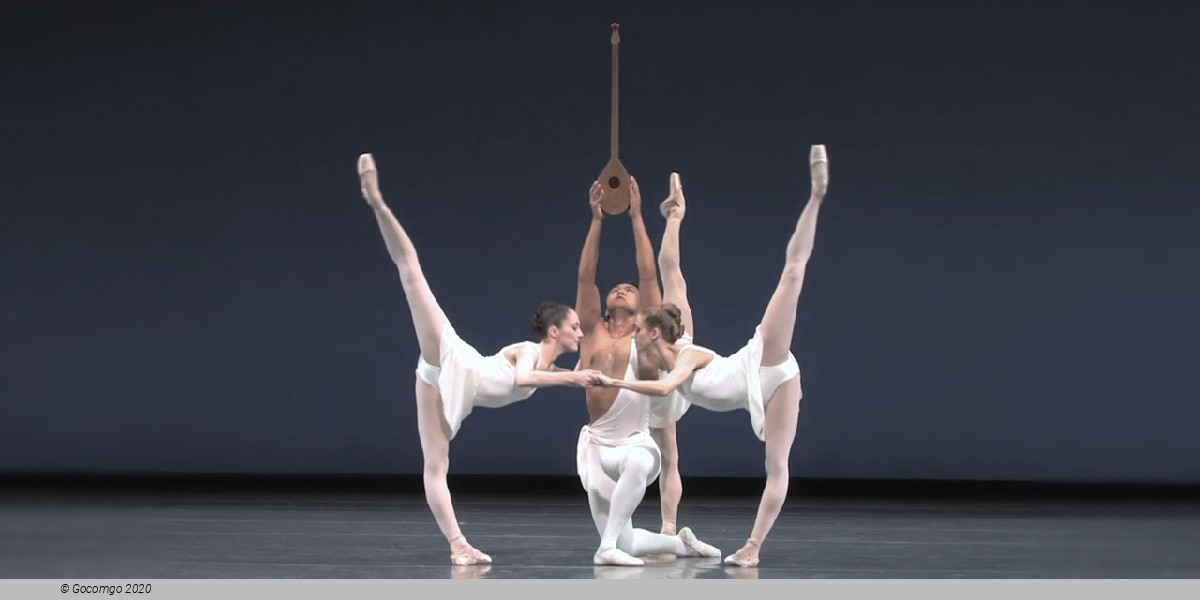Apollo
Apollo

Apollo (originally Apollon musagète and variously known as Apollo musagetes, Apolo Musageta, and Apollo, Leader of the Muses) is a neoclassical ballet in two tableaux composed between 1927 and 1928 by Igor Stravinsky.
It was choreographed in 1928 by twenty-four-year-old George Balanchine, with the composer contributing the libretto. The scenery and costumes were designed by André Bauchant, with new costumes by Coco Chanel in 1929. The scenery was executed by Alexander Shervashidze, with costumes under the direction of Mme. A. Youkine. The American patron of the arts Elizabeth Sprague Coolidge had commissioned the ballet in 1927 for a festival of contemporary music to be held the following year at the Library of Congress in Washington, D.C.
The story centres on Apollo, the Greek god of music, who is visited by three Muses: Terpsichore, muse of dance and song; Polyhymnia, muse of mime; and Calliope, muse of poetry. The ballet takes Classical antiquity as its subject, though its plot suggests a contemporary situation. It is concerned with the reinvention of tradition, since its inspiration is Baroque, Classical, or even post-baroque/rococo/galant.
It is scored for chamber orchestra of 34 string instruments.
Music
Stravinsky began composing Apollo on 16 July 1927 and completed the score on 9 January 1928. He composed for a refined instrumental force, a string orchestra of 34 instrumentalists: 8 first violins, 8 second violins, 6 violas, 4 first cellos, 4 second cellos and 4 double basses.
The commission from the Library of Congress and underwritten by Mrs. Elizabeth Sprague Coolidge paid him $1,000 for the piece, which was required to use only six dancers, require a small orchestra, and last no more than half an hour, but allowed him free choice of subject. Stravinsky had been thinking of writing a ballet on an episode in Greek mythology for some time and decided to make Apollo, leader of the muses, its central figure while reducing the number of muses from nine to three. They were Terpsichore, personifying the rhythm of poetry and the eloquence of gesture as embodied in the dance; Calliope, combining poetry and rhythm; and Polyhymnia, representing mime. Stravinsky explained the original title Apollon Musagète to mean "Apollo, Leader of the Muses".
Stravinsky wrote for a homogeneous ensemble of bowed string instruments, substituting contrasts in dynamics for the contrasts in timbre he employed in Pulcinella. The ballet takes its inspiration from the grand tradition of French 17th- and 18th-century music, in particular that of Lully, a source Stravinsky returned to when composing Agon in 1957. The prologue begins with dotted rhythms in the style of a French overture. The work relies on a basic rhythmic cell, presented at the beginning of the work, which Stravinsky transforms by subdivisions of successive values that become increasingly complex. Stravinsky revised the score slightly in 1947. In 1963, he indicated he intended to make further changes, particularly with respect to double-dotting many of the dotted-rhythm passages in Baroque style.
Ballet
The first ballet version of Stravinsky's Apollon musagète, commissioned especially for the Washington festival, premiered on 27 April 1928 with choreography by Adolph Bolm, who also danced the role of Apollo. Adolph Bolm put together a company of dancers for the premiere in a country which, at that time, lacked a readily available source of classically trained dancers. Ruth Page, Berenice Holmes (Gene Kelly's ballet teacher), and Elise Reiman were the three Muses and Hans Kindler conducted. Stravinsky took no interest in the U.S. performance, and Bolm's choreography is now practically forgotten.
He had reserved the European rights to the score for Sergei Diaghilev, whose Ballets Russes production, choreographed by the 24-year-old Balanchine, opened at the Théâtre Sarah Bernhardt in Paris on 12 June 1928. Stravinsky conducted the performance. The concertmaster was Marcel Darrieux.
In accordance with Stravinsky's wishes, the style of dancing was essentially classical, and Stravinsky thought of "Apollon musagète" as a ballet blanc, that is, costumed in traditional minimal white. Balanchine later said that when he heard Stravinsky's music all he could see was pristine white. The clarity, calm, even serenity of the music makes it seem infinitely remote from the colorful excitement of Stravinsky's earlier ballets. The avoidance of any conflict in the scenario, of any narrative, psychological or expressive intent, was further matched by monochrome costumes for the dancers and the absence of elaborate scenery on stage.
The scenario involved the birth of Apollo, his interactions with the three Muses, Calliope (poetry), Polyhymnia (mime) and Terpsichore (dance and song), and his ascent as a god to Mount Parnassus. The original cast included Serge Lifar as Apollo, Alice Nikitina as Terpsichore (alternating with Alexandra Danilova), Lubov Tchernicheva as Calliope, Felia Doubrovska as Polyhymnia and Sophie Orlova as Leto, mother of Apollo.


